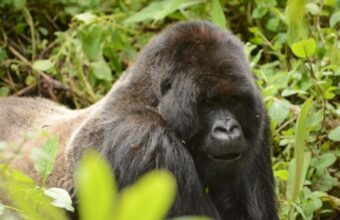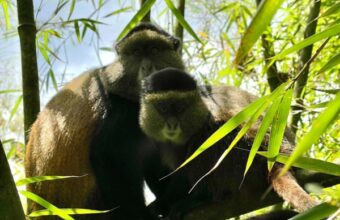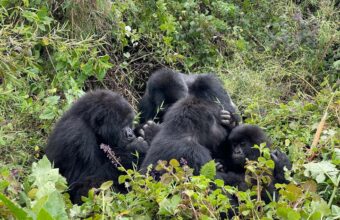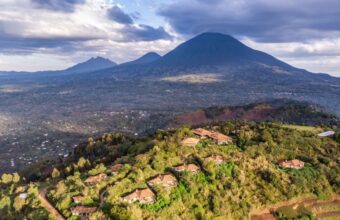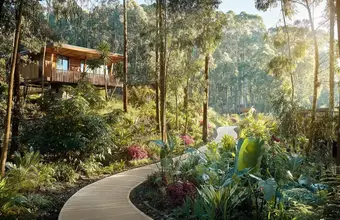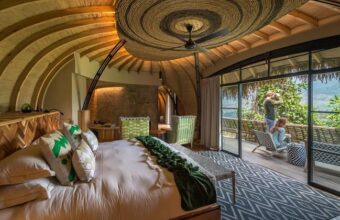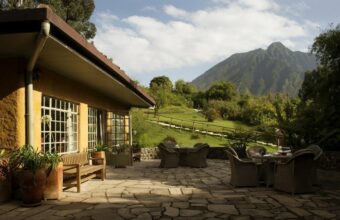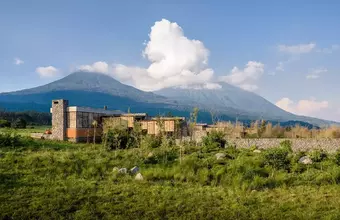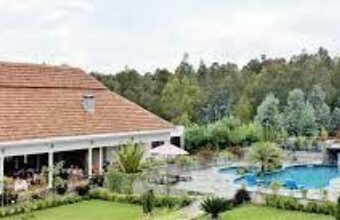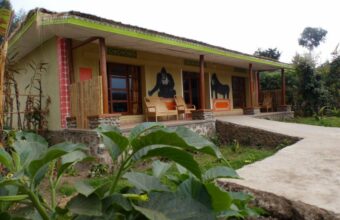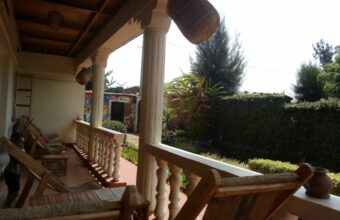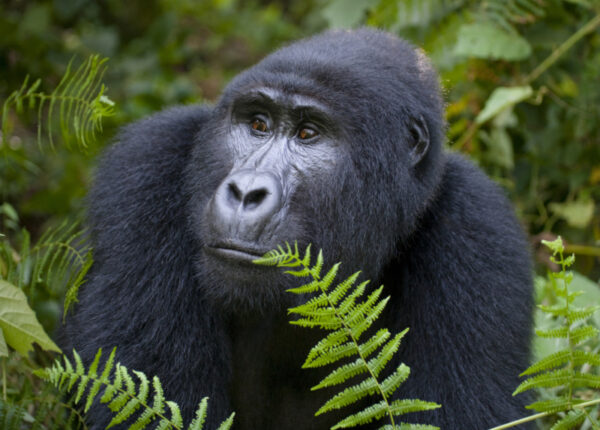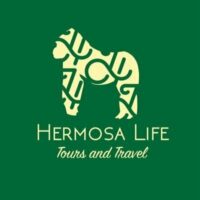Gorilla trekking in Rwanda
Where to see mountain gorillas in Rwanda
I’ve been lucky enough to go gorilla trekking in Rwanda several times over the 15 years that I’ve been living in East Africa.
My time here working as a conservationist, journalist and travel writer has given me unique access to local communities, conservation organisations, primate researchers, rangers, and the magnificent apes that they’re all working to protect.
Rwanda gorilla trekking: Essential info
- Rwanda is the more exclusive, higher-end gorilla safari destination. Rwanda’s gorilla trekking permits are significantly more expensive than in Uganda. Accommodation is generally skewed towards the luxury end of the market, although there is a range to suit most budgets.
- The Rwanda gorilla trekking experience is also considerably more accessible and convenient. If you have less time, or are a less confident hiker, I normally suggest Rwanda.
- Rwanda’s habituated gorilla families all live in Volcanoes National Park (VNP), which makes organising your trip fairly simple. VNP is just a two-hour drive on good roads from Kigali International Airport.
- Rwanda’s gorilla trekking region is accessed via gently sloping farmland. Inside the park is a variety of habitats: bamboo forest, open bush and darker, moss-covered trees with rocky paths. The higher you climb, the denser the forest becomes. Although you still need to be fairly fit to go gorilla trekking in Rwanda, the terrain is generally easier-going than gorilla trekking in Uganda.
Ready to learn more? Read on for my essential guide to gorilla trekking in Rwanda.
Where to go gorilla trekking in Rwanda

Volcanoes National Park
Accessible gorilla safaris in Volcanoes National Park
Volcanoes National Park, which protects the Rwandan slopes of the volcanic Virunga Mountains, has positioned itself as Africa’s premier gorilla tracking destination. One reason for its popularity is that it lies a short drive north of the Rwandan capital Kigali, making it a convenient add-on to any multi-country African trip or Big Five safari elsewhere in the region. Another is the association with Dian Fossey; the iconic primatologist worked here for two decades prior to her death, and several scenes in the Oscar-winning movie Gorillas in the Mist were shot here too.
In my experience, Volcanoes generally offers relatively easy tracking conditions compared to Bwindi, its main rival, and the range of luxury lodges bordering the park is second to none. A negative for budget conscious visitors is the relatively hefty price tag of US$1,500 for one of the park’s 96 daily tracking permits. Once here, other recommended activities include tracking a habituated troop of endangered golden monkeys, the day climb to the spectacular crater lake at 3,711m summit of Mount Bisoke, and a hike to Dian Fossey’s grave at her abandoned research centre.
rwanda gorilla treks
Rwanda's best gorilla trekking lodges
Some well-known, and less-popular, accommodation
One of the advantages of choosing Rwanda for your gorilla trek is that everyone starts at Volcanoes National Park HQ in Kinigi, which is just two hours’ drive from the capital, Kigali. This makes the morning logistics much simpler than in neighbouring Uganda, which has numerous starting points. In Rwanda, most lodges are within 15 to 30 minutes’ drive from the park entrance.
Here are a few of Rwanda’s most popular gorilla trekking lodges, plus some hidden gems you might not see elsewhere.
-
Volcanoes National Park
-
Volcanoes National Park
-
Volcanoes National Park
-
Volcanoes National Park
-
Volcanoes National Park
-
Volcanoes National Park
-
Volcanoes National Park
-
Volcanoes National Park
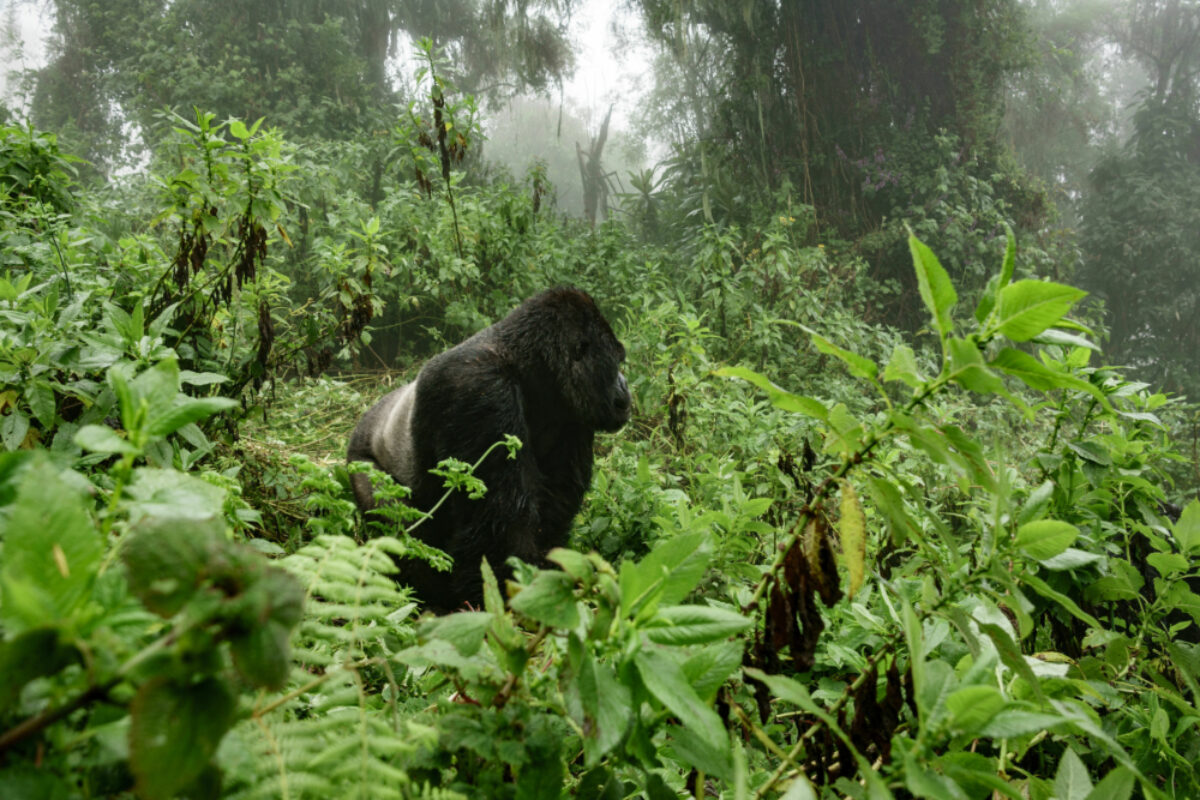
Gorilla trekking in Rwanda's Volcanoes National Park
Gorilla trekking in Rwanda: Need to know
Everything you wish you'd known before you booked
This is a straightforward country to visit, and Rwanda’s gorilla trekking industry is well organised and highly professional. That said there are a few things about gorilla trekking here that you might not know.
What to expect on the day
It’s a big day with an early start and potentially hours of hiking, so make sure of an early night the day before. I was so excited on the eve of my first gorilla trek that I barely slept a wink. (My bleary-eyed selfie is testament to that!)
Your lodge or tour operator will organise a transfer to the park headquarters for registration and a briefing between 7:30-7:30am. You’ll get an important reminder of the regulations and safety guidelines and your group will be assigned to visit a specific gorilla family.
You’ll usually trek for at least an hour before you reach your gorilla family. In some cases, it may take three or more hours before you find your group.
The scenery is stunningly beautiful, and the hike is all part of the experience. Be sure to keep your own pace and drink twice as much water as you think you’ll need. I find it surprisingly easy to get dehydrated.
As you come within range of your gorilla family, the rangers will ask you to leave your bags so you can approach the group more closely. Once you make contact, you’ll spend an hour with the gorillas. They may be hanging from trees, grooming, suckling their babies, playing, sleeping, farting or mating. Your hour with the gorillas may be calm or it may be full of drama! One thing is for sure, the hour will fly by. My biggest tip is to just enjoy being in their presence: don’t spend the whole time watching them through your camera screen.
If the gorillas are on the move, you’ll be able to move with them, keeping the required minimum distance of ten metres at all times. They may ignore you or show some interest and approach you. This is normal, exciting and – because of their size – a little scary too! It’s all part of the fun.
If the gorillas do approach, the rangers will reassure you and ask you to calmly step back. The rangers are highly knowledgeable; they will show you how to vocalise like a gorilla, and help you notice their behaviour and traits. I find talking to the guides an integral part of the experience. They know each gorilla family and their personalities intimately, tap into their wealth of knowledge about the gorillas, the forest and conservation issues.
Depending on where you are, you’ll find the gorillas in very different settings: I first saw them in dense dark forest; I’ve watched them in an open clearing, with clear views and plenty of sunlight; I’ve seen them balance precariously in the bamboo above my head! Keep lighting conditions in mind when planning your photos as flash photography is strictly prohibited.
The altitude, the dark forest, the rain and mud can make gorilla trekking hard work, but it’s always worth the effort.
Pro tip
Remember you’re allowed just one hour of contact time. Many visitors find the gorillas more interesting when they’re resting, family clustered together, snoozing, grooming and playing. When you approach, ask your guide if they are on the move and, if they are, if you can wait for them to stop before making contact.
Speak up before setting off!
The gorilla family that you’re assigned to visit is determined by your group’s trekking ability and preferences.
The park authorities closely monitor the whereabouts of each family and they have a good idea of their distance from headquarters. Some families are within an hour of easy hiking, others could be four or more hours away from HQ. The authorities will assign you to a gorilla family that is suited to your preferences and personal fitness.
So, if you have any preferences for a shorter (or longer) trek, I urge you to speak up at the morning briefing and you’ll be assigned to track the most appropriate gorilla family.
If you’re travelling with a big group this could mean splitting up – younger or fitter members trekking to a more distant family, and older or less mobile members visiting a more accessible family. It’s up to you, and the rangers will try to accommodate your preferences.
Hire a porter
At the morning briefing you’ll have the option of hiring a porter for the day. The going rate for a porter is around USD $20 (plus optional tip), and I can’t recommend it highly enough. Their help is absolutely invaluable. I really appreciate having my hands free to take photos or grab hold of a branch as I’m climbing a slope. Porters are more than happy to carry extra water (so there is no excuse for getting dehydrated). If it gets muddy, you have a strong pair of hands to help you scramble up the hillside.
It’s also a fun way to interact with the locals, and it provides useful income in a community that has little access to cash jobs. Portering makes a valuable contribution to local livelihoods, and therefore directly supports gorilla conservation through tourism. In these areas, most people are subsistence farmers; having an opportunity to earn some extra cash is extremely well received.
If you’re unsure of your physical ability, it’s also possible to hire an unglamorous-sounding “stretcher” which is carried by a group of porters. The use of a stretcher costs around USD $100 plus tips.
How to get gorilla tracking permits
You are required to have a permit to track gorillas in Rwanda, and permits currently cost USD $1,500 per person.
It’s a lot of money and is significantly more expensive than [gorilla tracking permits in Uganda] or the DRC. Rwanda positions itself as a high-end, responsible tourism destination, and the price is set to reflect that.
Rwanda gorilla trekking permits can be purchased directly from the Rwanda Development Board website or via a registered tour operator.
Permits are limited and their numbers are determined by the number of habituated gorilla families: Volcanoes National Park has 12 habituated gorilla families, there’s a maximum of eight visitors per family (not including guides and porters), which means a maximum availability of 96 permits per day.
Despite their high cost, permits do sell out during the peak summer and Christmas seasons, so I strongly advise booking well ahead. In fact, it’s common for people to book a year or even two in advance.
Advance booking is definitely recommended for peak times of year or larger groups, but if you are travelling during rainy seasons (approximately April and November) you might be able to fly into the country and buy your permit when you get there. There aren’t any last-minute discounts, so I wouldn’t risk it.
Permits are not transferable or refundable, except in exceptional circumstances. If you are ill on the day of your permit, particularly if you have a contagious disease such as COVID or flu, you may be able to postpone your trek if you or your tour operator contacts the authorities, but this can’t be guaranteed.
In my 15 years of trekking with gorillas, I’ve only once heard of a group not encountering their gorilla family, and they were given a complimentary permit to track again the next day. Since then, monitoring (assisted by GPS) has become more thorough so you can safely assume that you’ll see the gorillas, although it’s not officially guaranteed.
A final comment on the permit system: with zero tolerance of corruption in Rwanda, you can be sure that your permit fee benefits the gorillas directly. The country has made huge strides in restoring and protecting key habitats – both in Volcanoes National Park and in other areas such as Akagera, Nyungwe Forest and the country’s newest national park, Gishwati-Mukura. Overall I think this is a tourism success story that deserves to be celebrated.
How to organise and book a gorilla trek
There are two ways to organise a gorilla trek in Rwanda: independently or via a tour operator.
Unlike in Uganda, in Rwanda it’s possible for travellers to purchase a gorilla trekking permit directly from the Rwanda Development Board. You can then find and book your own accommodation. Most lodges and hotels are happy to take direct bookings, and they may also be able to organise your transfers to/from the airport and to the park entrance on the morning of your trek. Depending on how intrepid you’re feeling you can rent a car in Kigali to get yourself around, or even travel on public transport (factor in likely delays to your itinerary).
If you do decide to travel independently, arrive at VNP a day early because if you’re late, that’s it: you’ll miss your permit and you won’t get your money back.
Because permits are limited and non-transferable, if you’ve got your heart set on a particular lodge, it’s prudent to check availability first, then book your permit, and then confirm your accommodation booking.
Alternatively, you can book the entire thing through a tour operator. They will arrange your gorilla tracking permit, book your accommodation and organise all the necessary logistics.
My advice is to book with a tour operator. Rwanda is an easy place to travel around but things can go wrong, and their support can be invaluable.
Don’t overlook local operators
There are many Rwanda-based operators as well as international travel companies, often with stark price differences between the two. International travel companies often subcontract local operators to run their ground operations, so you may wonder why you’re paying a premium to a middleman. Generally speaking, international operators can offer an extra edge on pre-trip communication, more hand-holding, and stronger financial protection.
On the other hand, a good local tour operator will have a stronger grounding in the local community and customs, might use smaller, independent accommodations or homestays, and can generally get you out of the international tourism bubble. And the biggest factor for me: much more of your money will stay in the local economy, instead of being syphoned off abroad.
My advice as a 15-year resident of East Africa: embrace the local connection, don’t rely on the highly curated experience of an international company. Dance with the locals, make banana beer, get your hands dirty and do a bit of digging in the fields. Get out of your comfort zone and find out what life’s really like in Rwanda. I guarantee you will have a more memorable trip as a result.
If you do book with a local tour operator, always check independent reviews and ensure they’re registered with the Rwanda Tours and Travel Association. Pay by credit card for financial protection, and always make sure you’re covered with travel insurance from time of booking.
Be prepared to shell out!
Rwanda pitches itself as the high-end gorilla trekking destination and this is reflected in the higher price of the permit and the bigger range of high-end accommodation. Rwanda has some sensational luxury properties and, in my experience, a fair number of overpriced mid-range ones, so do your homework.
Typical accommodation costs in Rwanda:
Budget : $20 - $50 per person per night based on two sharing
Mid-range: $80 - $250 per person per night based on two sharing
Luxury: $300-$3,000 per person per night based on two sharing
Rwanda’s gorilla trekking region is only two hours’ drive from Kigali. In theory this means you can save on transport and accommodation by doing a shorter trip then you can in Uganda.
A two-day gorilla itinerary – the most popular option – starts from £1,900. A three-day luxury gorilla safari may cost $2,000 to $5,000 per person. Tours include one gorilla tracking permit, private transport, English-speaking guide, accommodation and meals.
It’s even possible to do a one-day gorilla tour in Rwanda from around $1,700 per person, but please don’t do that. My advice is to slow right down: don’t rush in and out just to track the gorillas – you’ll be doing yourself and your hosts a great disservice. Rwanda wants to nurture responsible tourists; we undermine those efforts by reducing the entire country to ‘just’ gorilla trekking.
Don’t discount off-season
In my experience, the best conditions for gorilla trekking in Rwanda are during the two dry seasons which run from June-September, and December-February. (Note that climate change is disrupting the timing of these seasons.) The advantages to tracking in dry season are less muddy paths, easier hiking and clearer views. The disadvantage is that these are the peak gorilla trekking seasons, demand for permits is higher, and accommodation is more expensive. You’ll need to book well in advance.
The rainy seasons, from March-May and September-November, can be very soggy but if you don’t mind the rain (and mud) the mountains will be quieter and you may find some good deals on accommodation. Saying that, just because it is called the rainy season, it doesn’t mean that it rains every day. There is no off-season discount on the gorilla tracking permit.
Whenever you come, you must bring your rain gear and some decent boots. Mountain gorillas live in the rainforest and most days have heavy dew, a light shower, a downpour, or all of the above!
A word about April: this is the month when Rwandans pause to commemorate the the 1994 genocide against the Tutsi in which nearly one million Tutsi were killed. Ceremonies take place at hundreds of sites across the country and visitors are welcome at these events. April is known as Kwibuka, which means “remember” in Kinyarwanda language. There is no live music, for example, during April and the country has a sombre air.
Overrated: whistlestop in & out itineraries
Lots of tour operator itineraries would have you rush through Volcanoes National Park and onwards to other safari destinations elsewhere in East Africa. I've even seen a fly in/out itinerary to see mountain gorillas and then leave Rwanda on the same day.
While these itineraries are technically possible, I really don't recommend them – there's much more to Rwanda than one hour with the gorillas! I always recommend that visitors plan to stay at least two nights in the vicinity of Volcanoes National Park. This will allow you to spend one night acclimatising and another recuperating after your trek.
And after you’ve seen the gorillas there’s plenty more to see and do in Rwanda with a growing range of wildlife and safari activities, including Akagera National Park (a big five destination) and Nyungwe Forest.
The capital, Kigali, is a well-organised city with some excellent cafés (serving Rwandan coffee of course) and art galleries. A visit to the world-class Genocide Memorial Museum may be painful yet is highly recommended after you have visited the gorillas. This history may go some way in explaining the more reserved nature of Rwandans.
Overall my main advice is to slow right down, and appreciate the privilege of being able to visit this little corner of a vast continent. By all means combine your trip with some of the other East African ‘big hitters’, but treating the entire country as a springboard to just see the gorillas just feels wrong to me.
Rwanda gorilla trekking FAQs
Your questions, our expert answers
Question
Can I organise a DIY gorilla safari in Rwanda?
Answer
There are two ways to organise a gorilla safari in Rwanda. You can either secure a permit yourself through the Rwanda Development Board and then try to book your transport and accommodation independently. You'll need to get yourself to the park entrance for the morning of your trek, if you book in a lodge near VNP they should be able to arrange transport for you.
Or you can book the whole thing through a licensed tour operator who will arrange your gorilla tracking permit, accommodation and all the necessary logistics. My advice is to book your trip with a tour operator. Rwanda is an easy place to travel around but things can go wrong, and their help can be invaluable.
Question
Should I book a gorilla safari with a local or international operator?
Answer
There are many locally-based operators as well as international travel companies, often with stark price differences between the two. International travel companies often use local operators to run the ground operations, so you may wonder why you’re paying a premium to a middleman. Generally speaking international operators can offer an extra edge of communication, more hand-holding, and stronger financial protection. To help keep more of your money within the local economy I think it’s worth considering booking locally, but do check independent reviews and try to pay on a credit card and with travel insurance for financial protection.
Question
How much does gorilla trekking in Rwanda cost?
Answer
In Rwanda a gorilla tracking permit ordinarily costs US$1,500 for international tourists.
At the time of writing, there are 96 permits available per day. You can buy your permit up to two years in advance through the Rwanda Development Board or through a registered tour company.
Rwanda pitches itself as the high-end gorilla trekking destination; this is reflected in the higher price of the permit and the bigger range of top-end accommodation. Rwanda has some sensational luxury properties and a fair number of overpriced mid-range ones, so book with caution.
Typical accommodation costs in Rwanda:
Budget : $30 - $50 per person per night based on two sharing
Mid-range: $80 - $250 per person per night based on two sharing
Luxury: $300-$3,000 per person per night based on two sharing
Rwanda’s gorilla trekking region is only two hours’ drive from Kigali, making the gorillas far more accessible than in Uganda. In theory this means you can save on transport and accommodation by doing a shorter trip. It’s possible to do a one-day gorilla trek in Rwanda from around $1,700 per person. A two-day gorilla tour will start from £1,900. A three-day luxury gorilla safari may cost $2,000 to $5,000 per person. Tours include one gorilla tracking permit, private transport, English-speaking guide, accommodation and meals. Charter plane and helicopter transfers are additional options.
My advice is to slow it right down and don’t rush in and out just to track the gorillas – you’ll be doing yourself and your hosts a great disservice.
Read more: Gorilla Trekking Prices
Question
When is the best time to go gorilla trekking in Rwanda?
Answer
Gorilla trekking in Rwanda can be done year-round, however, rainfall is heavier in September-November and March-May, when paths can become muddy and difficult to hike.
Remember that you’re visiting a rainforest. It will, by definition, be wet all year round!
That said, there is still a marked difference between the dry and rainy seasons. The weather is generally drier and hotter between June and September, and again from December to February. These are my preferred months to go gorilla trekking in Rwanda.
During March and May, and again from September to November you can expect more frequent and heavier rain showers. Muddy roads and paths can become tricky to handle.
Temperatures are fixed year round between 21°C (70 F) and 30°C (86 F), dropping to 10°C (50 F) at higher altitudes. Although chilly at night, the exertion of hiking and climbing will keep you warm during the day.
The advantages to visiting in dry season are less muddy paths, easier hiking and clearer views of the wildlife. The disadvantage is that this is peak tracking season and therefore permit availability is lower. You’ll need to book well in advance.
Peak season & when to book
Peak tourism seasons are June to August and around Christmas and New Year. If you plan to go gorilla trekking in Rwanda during peak season or if you are in a large group, you should book six months or more in advance. The earlier you book the more choice you have on where you trek gorillas and where you stay. Last-minute bookings may be possible during low season or with smaller groups.
Aside from more choice in permit and accommodation availability, there are some other pros to visiting during rainy season—not least that smaller group sizes allow a more intimate tracking experience.
If you have little time it is, in theory, possible to see mountain gorillas in Rwanda in just one day—if you fly in very early in the morning. However, it is strongly recommended to spend at least two or three days in the region. The altitude and exertion of the climb can be unpleasant when rushed, and it is worth spending some time to explore Rwanda and its culture beyond just gorillas.
Events and festivals
The annual Kwita Izina gorilla-naming ceremony takes place every September and offers a fascinating insight into Rwandan culture and the country’s efforts to promote gorilla conservation. The event is free to attend, but by invitation only. A good tour operator will be able to arrange access for you.
A more solemn occasion is Kwibuka, which means remember in Kinyarwanda. This is a series of events held in April in commemoration of the 1994 genocide in which nearly one million Tutsi—70% of the Tutsi population—were killed. Visitors are welcome at these events.
Question
I am considering a gorilla safari in Rwanda in the first week of October. What is it like in terms of rain? I'm not super fit, is it likely to be very muddy and challenging? Thank you!
Answer
If you're tracking in Rwanda at the beginning of October, you may be lucky and not have too much rain. (It's November that is typically the wettest season during the year's late rains).
But to be honest, it can rain any day of the year, particularly in the afternoons. However, with good preparation you can still enjoy visiting the gorillas.
Firstly, make sure you have the right equipment: sturdy walking boots that cover and support your ankle, for example. Locals often prefer wearing gumboots but I prefer the non-slip grip of walking boots. Regardless of the time of year you track, we always recommend wearing layers e.g. thin longsleeve T-shirt, a light pullover fleece, plus a rain jacket. On the day you track, the rangers will assess your fitness level, and allocate you a group to suit you.
You don't need to be mega fit. You will be supported by the rangers and can also hire a porter. Invaluable! This means you don't have to worry about carrying your backpack. Nor do you need to worry about the mud, the weather or the distance since you'll have plenty of hands to literally lift you up, if needs be. You can also borrow, buy or hire a walking stick. Sometimes, someone will grab a piece of bamboo and make you one.
Make use of every bit of help that is offered. It's all part of the fun! I think you'll be fine. Enjoy!
Question
I'm trying to purchase a gorilla tracking permit for Rwanda but the website isn't working, what should I do?
Answer
Unfortunately the Rwanda Development Board gorilla permit portal can be unreliable! You may want to contact them directly on reservation@rwandatourism.com, alternatively you'll probably find it a lot easier to purchase your permits via a tour operator.

